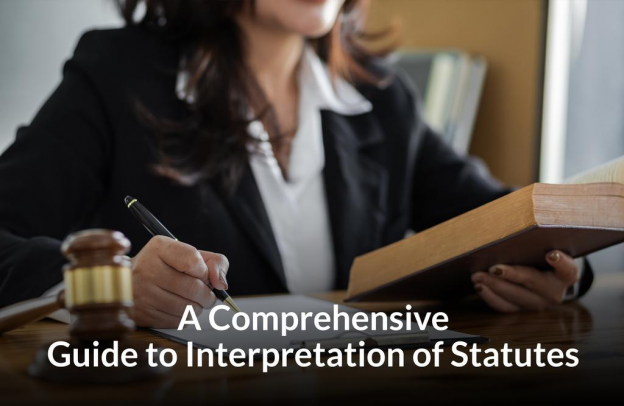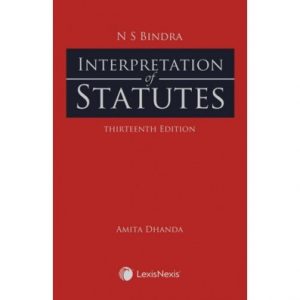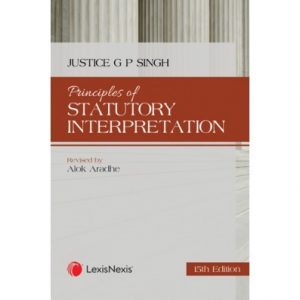A Comprehensive Guide to Interpretation of Statutes

Interpretation is the process to determine the meaning of the statutes or other legal provision. Statutes are also known as legislative enactment or backbone of any legal system. These statutes are the primary source of most of the law jurisdictions. And statutes are play the vital role in regulation of all aspect of the society.
The judiciary holds an essential responsibility of interpreting the existing statutes and laws. When courts administer justice in disputes they strictly adhere to the boundaries established by the framework, which includes various laws, statutes, the Constitution and delegated legislations. In nations, like India, the legal framework comprises a multitude of legislations and regulations.
This interpretation of statues is challenging and complex but this is the most important part to ensuring that, law is applied fairly and uniformly.
What is Interpretation of statutes?
Interpretation of statutes is the backbone of our legal system. This is the process of determining the meaning of any law. This interpretation of statues is challenging and complex but this is the most important part to ensuring that, law is applied fairly and uniformly.
Statutes are the primary source of most jurisdiction in law. It is a law enacted by a legislative body. Statutes play the most vital role in regulating all aspect of our legal system. But at the same time it can be quite complex, that time interpretation of statues comes in.
What is Construction of Statutes?
Statutory construction also referred as Interpretation of statutes. It is a fundamental legal processor. The use of Constructed of Statutes is to determining the meaning and application of statutes. It is also challenging and complex in task but it ensures that the law is applied uniformly and fairly.
To understand a statute, courts use variety of tools and techniques. There are a set of principle and rules use to interpret the statutes. Court generally give the plain and ordinary meaning of the statutes, unless the statute is confusing or that meaning would lead to a wrong result. Sometimes courts may consider the legislative history of a statute like committee reports and debates to help to understand the statute’s meaning.
Related books
“Interpretation of Statutes” by N S Bindra

“Principles of Statutory Interpretation” by Justice G P Singh

Difference Between Interpretation and Construction
INTERPRETATION
Interpretation and construction form the principles in analysing statutes allowing courts to effectively apply and uphold the rule of law. Although these concepts are interconnected they serve purposes in comprehending and implementing statutes. Interpretation involves understanding and discerning the meaning of language as an art form. Lawmakers use words and phrases when drafting statutes to convey their intentions and establish rules. However due to language complexities and multifaceted nature of matters statutes may not always express their intended meaning with clarity. Consequently, courts play a role in interpreting language to uncover legislative intent.
The objective of interpretation is to address questions about what the law states and what it was intended to achieve. It delves into context, purpose and objectives of the law to determine the intent, behind its wording. Judges meticulously analyse the wording, sentence structure and organization of the statute to understand its intended meaning.
When it comes to the law construction focuses on how it’s applied to specific cases or situations. Once the court has understood the meaning of a statute the next step is to put that meaning into action, in real life scenarios. This is where construction comes into play.
CONSTRUCTION
Construction deals with implementing and enforcing the law. It involves adapting the language of statutes to address circumstances and determining how the law should be enforced in cases. Through construction courts decide how to put the law into practice in order to resolve disputes protect rights and ensure justice.
The main difference between interpretation and construction lies in their scope and emphasis. Interpretation primarily aims at understanding and revealing intent while construction involves applying that intent to situations. Interpretation provides guidelines, for construction by establishing boundaries within which courts can consistently and fairly apply the law. In practice interpretation and construction are closely connected. The court’s interpretation of a statute influences how it constructs its rulings in cases. Hence, we can also safely assume that the outcomes of case laws will be a crucial part in interpreting future statutes.
OBJECTIVES OF INTERPRETATION OF STATUTES
The goals and objectives which interpretation of statutes seeks to be achieved can be summarized as follows;
- 1. Understanding the intent of the legislators: The main goal of interpretation is to comprehend what the lawmakers intended when they made and passed a law. This involves analysing the language used in the statute taking into account its context and examining the circumstances surrounding its creation.
- 2. Achieving the purpose for which the statute was brought into force: Once we have determined the intent the next objective is to ensure that the statutes purpose is fulfilled. This means interpreting it in a way that aligns with the goals intended by lawmaker.
- 3. Protecting rights and freedoms: Statutory interpretation should also prioritize safeguarding individual’s rights and liberties. It entails interpreting laws in a manner that does not unreasonably infringe upon people’s rights and freedoms, but rather help them
In addition, to these objectives there may be aims to certain cases. For example, a court might interpret a statute in a way that minimizes its impact, on the economy or promotes welfare.
AIDS TO INTERPRETATION OF STATUTES
Statutory interpretation can be a complex process due to inherent ambiguities and varying legislative intent. To aid in accurately understanding statutes, legal practitioners and courts rely on various tools known as “aids to interpretation.” There are statutory as well as non-statutory aids: –
A) Statutory Aids:
- These include additional information provided within the statute itself, such as definitions, explanations, schedules, and other provisions. In State of W.B vs Anwar Khan, the court relied upon on the statutory aids within the legislation to determine the legislative intent and constitutionality of the WB Special Courts Act of 1950.
- Preambles: Introductory statements that precede a statute and provide context and background. In The State of Rajasthan v. Basant Nahata (2005), the Supreme Court of India relied on the preamble of the Prevention of Corruption Act, 1988, to understand the law’s purpose and combat corruption.
- Marginal notes: Marginal notes are notes that are sometimes placed in the margins of statutes. These notes can provide helpful summaries of the key provisions of the statute.
B) Non Statutory Aids:
To interpret and understand laws there are non-statutory sources that can be consulted:
- 1. Legislative History: This includes records of debates committee reports, speeches made during parliament sessions and other related materials that led to the law’s enactment.
- 2. Dictionary Definitions: Standard dictionaries can be used to determine the meanings of words within a statute. For example, in R v. Harris (1836) the court relied on definitions to interpret the term “steal” as defined in the Theft Act 1968.
- 3. Case Law: Previous court decisions serve as precedents. Provide guidance for interpreting statutes ensuring consistency, in reasoning. In the landmark decision of Mahalaxmi Oils Mills, v. State of A.P. the SC observed how the term “tobacco” was defined in law by the lawmakers. Interpreting the law led the SC to state that tobacco encompassed all types of tobacco regardless of whether it was cured/uncured, produced or not as the stems and leaves of the tobacco plant. The Court concluded that this definition was comprehensive but did not include tobacco seeds.
IMPORTANCE OF INTERPRETATION
The process of understanding the meaning of a law or legal provision is known as interpretation. It is an aspect of our system enabling courts and other bodies involved in adjudication to apply the law to specific cases and resolve legal disputes fairly.
Interpretation plays a role, in preventing the exercise of power and ensuring that duties are fulfilled. If a statute is written in ambiguous language government officials may interpret it in ways that allow them to wield their powers arbitrarily. However when courts interpret statutes they can ensure fair application of the law while preventing abuse of power by government officials.
Interpretation is also instrumental, in preventing crime and safeguarding welfare. If criminal statutes are interpreted narrowly they may not effectively deter crime. Conversely if they are interpreted broadly individual’s rights may be violated. Courts have a role to play in interpreting statutes in a manner that both prevents crime and safeguards individual rights.
Lastly interpretation contributes to expediting the delivery of justice. If the courts struggle to promptly and accurately understand the law it can result in delays, within the proceedings. Such delays can have effects on both plaintiffs and defendants eroding trust in the judicial system. To guarantee justice courts should establish consistent guidelines, for interpreting the law.
RULES OF INTERPRETATION
There are so many rules of interpretation used in law.
- Literal Rule: This rule is the most basic rule in interpretation, which states that words, in a law should be given their ordinary and plain meaning unless it would lead to an absurd or unreasonable outcome.
- Golden Rule: Another rule is golden rule which is departure from the literal rule, which allows courts to modify the meaning of a law in order to avoid absurd or unreasonable results. However this rule is only applied when the literal meaning of the law is clear and unambiguous.
- Rule of Harmonious Construction: The rule suggests that laws should be interpreted in a way that aligns with laws to prevent conflicts between them.
- Mischief Rule: It permits courts to consider the problem or issue that a law was meant to address when interpreting it. This helps ensure that the law remains true, to its purpose.
- Purposive Approach: This rule focuses on understanding and interpreting laws based on their intended purpose.
- Ejusdem Generis Rule: It states that when general words follow a list of words they are limited to the category or class as those specific words.
- Noscitur a Sociis Rule: This rule states that meaning of a word or phrase can be determined by the context provided by surrounding words or phrases.
- Expressio Unius Est Exclusio Alterius Rule: This rule suggests that mentioning one thing implies excluding another.
- Presumption of Consistency: The principle of consistency asserts that laws and legal documents are assumed to be, in agreement with each other. This assumption is made to prevent any contradictions between laws or different sections, within the law or document.
CONCLUSION
Interpreting statutes is an intricate responsibility, within the system. It plays a role in enabling courts and other adjudicating bodies to apply the law to individual cases and resolve legal disputes. These guidelines are designed to ensure consistent application of the law maintain its relevance and effectiveness and uphold justice. In addition to these rules and principles lawyers also utilize external aids for interpretation. These aids assist lawyers in comprehending the meaning and purpose behind a statute allowing them to determine its interpretation. Interpreting statutes is undoubtedly complex but undeniably vital, within our system.
FAQ
1. What is the interpretation of statutes?
Interpretation is the process to determine the meaning of the statutes or other legal provision. Statutes are also known as legislative enactment or backbone of any legal system. This interpretation of statues is challenging and complex but this is the most important part to ensuring that, law is applied fairly and uniformly.
2. What are the two kinds of interpretation of statutes?
Two kinds of interpretation of statutes are: Literal interpretation and Purposive interpretation
3. What is golden rule of interpretation?
Golden rule of interpretation is, which allows courts to modify the meaning of a law in order to avoid absurd or unreasonable results. However this rule is only applied when the literal meaning of the law is clear and unambiguous.
4. What is the purpose of interpretation?
i) To determine whether a particular conduct is prohibited by law
ii) To determine whether a government agency acted lawfully
5. Who interprets the statutes?
Statutes are interpreted by courts, including trial courts, appellate courts, and the Supreme Court.
6. What is the famous case of interpretation of statutes?
Mahalaxmi Oils Mills, v. State of A.P. the SC observed how the term “tobacco” was defined in law by the lawmakers. Interpreting the law led the SC to state that tobacco encompassed all types of tobacco regardless of whether it was cured/uncured, produced or not as the stems and leaves of the tobacco plant. The Court concluded that this definition was comprehensive but did not include tobacco seeds.

